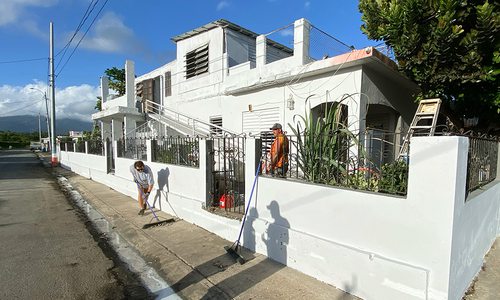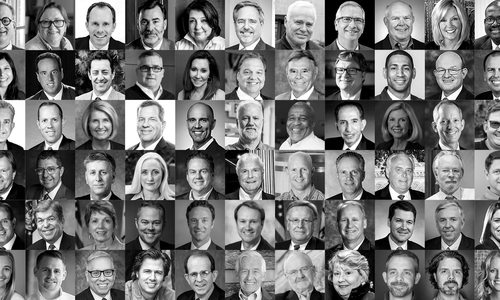
Bethesda Medical Care’s office was designed with an aviation feel, keeping in line with Dr. Bill Graham’s designation as an FAA-certified physician. Photos By Brandon Alms.
The Doctor Will See You Now
We’ve all been there. You feel under the weather and have to head to the doctor, but instead of quick relief for your symptoms, you’re given an appointment weeks or months away, you sit in a waiting room for an hour only to have facetime with doctors for seven to 15 minutes, and then you’re sent home with a prescription and a bill, leaving you frustrated (and not because of your prolonged sniffles). The issue isn’t your doctor, who in almost every case is trying to provide you the best possible care. The root cause is the bottom line.
Each doctor’s office has to hire extensive administrative staff to handle the complicated paperwork and billing required to bill patients’ insurance companies. The insurance companies set the price per visit, so in order to generate enough revenue to pay for this admin staff, doctors have to see 20 to 30 patients each day, spending no more than 15 minutes with each patient, meaning their patient panel often reaches 2,500 people. As you can imagine, this makes for an exhausting day for the physicians, leaving them feeling drained and leaving patients feeling like a commodity rushed through a system. Dr. Tim Fursa, founder of Triple Aim Direct Primary Care, served as program director for Cox Family Medicine Residency program and recognizes this problem firsthand in his former residents. “They’ve reached the point where they’re done with their training, they’re board-certified family physicians, you would think they would be at the height of having achieved their life’s goal, but what I discovered was talking to them two or three years after graduating from their program, they find their experience was less than they thought it would be,” he says. “It’s not as rewarding as they thought it would be. That really broke my heart because you want them to be happy about their career and [you want it to be] what they’re doing for the decades. This phenomenon we’re seeing nationwide.” And it’s a phenomenon that coincides with an approximately 55 percent burnout rate in family care physicians, according to Dr. Shelby Smith, partner at Equality Healthcare.
A Shimmering Solution
Although the situation seems grim, creative thinkers in the medical industry have proposed a solution: Direct Primary Care (DPC). In this model, insurance is taken out of the picture, removing the costs associated with insurance billing and paperwork and eliminating the pressure to see such a high volume of patients. Doctors in a DPC model work in independent clinics and see between 400 and 600 patients (practically a quarter of a traditional patient panel). Everything is run at cost, and patients pay a monthly or yearly membership fee in exchange for much more facetime with a doctor. Visits typically last a half an hour to an hour, and doctors have a much smaller patient base, meaning they can form a deep and lasting relationship.
“The touchstone of Direct Primary Care in our practice is we take the time to listen to our patients,” says Dr. Bill Graham, founder of Bethesda Medical Care, a DPC clinic. Because they have more time between patients, Dr. Graham and his staff can be advocates for their patients’ health when, in a traditional setting, they did not have the time to devote to researching other options. For example, when one of Dr. Graham’s patients could not afford the sleep apnea machine he needed, Daisy Manteris, the medical assistant at Bethesda Medical Care, was able to research alternative options and found a program that would donate a machine for free. “We never had that option before,” she says. “Even though we wanted to help, we didn’t have the time or freedom to do so.” This is a far cry from the hurried and fast-paced insurance-based system, which patients have come to see as a transactional event: I need a prescription and you can give it to me. “In the transactional event, when the clinic visit is done, the care is done,” Dr. Fursa says. “In the relationship experience, when the visit is done, the care is just beginning because the relationship is just beginning, and it continues to blossom from there. It’s in the care that happens behind the scenes when the patient isn’t even in the clinic that the relationship becomes really beneficial.”
Becoming Health Advocates
That relationship-driven aspect of DPC makes family medicine an ideal match for the model because at its root is long-term doctor-patient relationships. “Primary care can take care of 95 percent of healthcare needs at a very reasonable cost,” Dr. Graham says. The doctors’ availability for their patients also opens up alternative avenues of communication through email, text, video and phone calls, or what Dr. Fursa calls an alternative context of care, allowing a doctor to be there for all of a patient’s questions on a journey to wellness.
“This model just makes too much sense,” Dr. Smith says, not only because of the increased access to a deep and beneficial relationship, but also because of the cost savings. A DPC membership fee for an entire year costs less than one visit to the ER before any procedure is even done. Some patients question if paying for a membership in addition to a monthly insurance premium is worth it, but Dr. Fursa stresses that you’re paying for the relationship, and if your plan has a high enough deductible, you would pay out of pocket for a doctor’s visit regardless.

Bumpy Roads to Clear Skies
As with any new idea, there are significant challenges getting it up off the ground and helping it spread. The biggest hurdle DPC faces involves insurance. Currently, Missouri approves DPC membership fees to be paid for by HSA or FSA accounts, but federally, DPC memberships don’t qualify for pre-tax savings. And though DPC can take care of the majority of your basic healthcare needs, patients still need coverage for catastrophic events such as car accidents or plans that include specialists. Currently, there are supplemental insurance plans available, but they leave gaps in coverage. Dr. Fursa and Dr. Smith say the next step is for more insurance companies to start developing wraparound plans made specifically with DPC in mind.
Once the DPC model becomes integrated with insurance plans, Dr. Fursa anticipates the model spreading beyond individuals and into small businesses that are typically priced out of comprehensive insurance plan options for employees.

True to its name, the Equality Healthcare office is located downtown within walking distance of a bus stop. The office was designed to be bright, clean and modern. The walls double as gallery space for displaying artwork for First Friday Art Walk.
An Open-Armed Model
DPC providers can relate to those small businesses because they themselves have to be small business owners. Dr. Fursa notes that this is sometimes a barrier to entry for physicians who are not in a place to accept the risk of opening their own practice. However, as the clinics grow and take on more patients, they will be looking to accept more partners to practice under their umbrella. This option provides an opportunity for physicians experiencing burnout to test the waters, see how the public is reacting to the model and then enter in a lower-risk way.
“If a physician is burnt out, I would encourage them to take a day off and spend some time with one of us here in town,” Dr. Graham says. He emphasizes that, unlike some pockets of medicine, the DPC community is very encouraging, open and collaborative. When Dr. Graham first started his practice in 2011, he was the first Direct Primary Care provider in Springfield. Several years in, he heard about a summit in St. Louis and attended. “I had no idea anyone was doing something as crazy as this,” he says. “I thought I was the only one.” Opportunities to connect with other DPC physicians creates a stronger network of healthcare providers locally. Some connections are forged through summits, and others through classic Springfield-strong networking. (For example, Command Family Medicine’s Dr. Luke Van Kirk jumped into DPC after learning his cousin, Dr. Josh Umbehr, founded DPC practice Atlas MD and became a leader in the field and a spokesperson for the movement.) Dr. Smith adds that, in addition to making connections, you need to be excited and believe in the model’s potential to disrupt the norm. “At its core, we can be part of a movement to transform healthcare,” he says.
Bethesda Medical Center
One-year memberships start at $420 per person
600 W. College St., Suite 120, Springfield
417-831-0022
bethesdamedical@att.net
bethesdamedicalcare.com
Equality Healthcare
Memberships are monthly, based on age and range from $30 to $150 for a family plan
420 W. College St., Suite 100, Springfield
417-633-7020
info@equality.healthcare
Equality.healthcare
Triple Aim Direct Primary Care
This consultancy model works with doctors looking to set up their own Direct Primary Care practices.
417-380-1319
tim@tripleaimdpc.com












 In fall of 2015, Mercy consolidated all of these administrative tasks into one hub called Mercy Research. The transition, which is slated to be complete July 1, should free up the clinical trials branches and Product Development & Informatics to focus on patient care and innovation. When these branches are running more efficiently and have more capacity, the Product Development & Informatics team plans to spread the word about what they do and the type of proposals they’re looking for. “We get lots of fabulous ideas, but because of our limited capabilities, we can’t push every idea into an invention or into a product,” Collison Farr says. She notes that, following the reorganization, their focus is on educating those within the Mercy network about the difference between an idea and an invention.
In fall of 2015, Mercy consolidated all of these administrative tasks into one hub called Mercy Research. The transition, which is slated to be complete July 1, should free up the clinical trials branches and Product Development & Informatics to focus on patient care and innovation. When these branches are running more efficiently and have more capacity, the Product Development & Informatics team plans to spread the word about what they do and the type of proposals they’re looking for. “We get lots of fabulous ideas, but because of our limited capabilities, we can’t push every idea into an invention or into a product,” Collison Farr says. She notes that, following the reorganization, their focus is on educating those within the Mercy network about the difference between an idea and an invention. 







 The team started spreading the word about the CoxHealth Innovation Accelerator, which took place February 29 through March 1. They encouraged those who were constantly proposing new ideas to apply for one of the event’s 50 slots. More than 100 people filled out applications, which simply asked for the applicant’s name and posed several questions differentiating between process improvement and innovation. From there, Rogers put the applicants in a spreadsheet and selected 25 frontline employees, 20 midlevel managers and directors and five senior leaders from different specialities, departments and locations. “We wanted [participants] to understand that senior leaders can be helpful, and though they have ideas themselves, they also can be supportive of your ideas,” Rogers says.
The team started spreading the word about the CoxHealth Innovation Accelerator, which took place February 29 through March 1. They encouraged those who were constantly proposing new ideas to apply for one of the event’s 50 slots. More than 100 people filled out applications, which simply asked for the applicant’s name and posed several questions differentiating between process improvement and innovation. From there, Rogers put the applicants in a spreadsheet and selected 25 frontline employees, 20 midlevel managers and directors and five senior leaders from different specialities, departments and locations. “We wanted [participants] to understand that senior leaders can be helpful, and though they have ideas themselves, they also can be supportive of your ideas,” Rogers says. 


